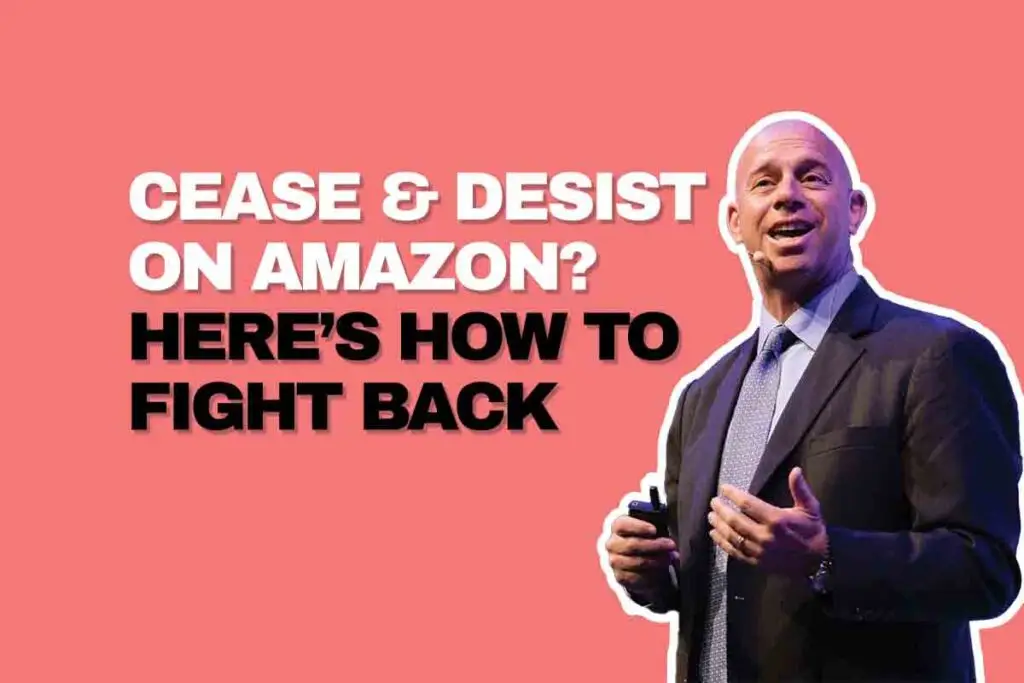Amazon Cease and Desist Letter? Here’s How to Fight Back & Keep Selling

Received a cease and desist letter on Amazon? You’re not alone. Every week, Amazon sellers and e-commerce business owners report receiving legal-looking letters demanding that they stop selling certain products. These notices can be intimidating – mentioning intellectual property rights, legal threats, and tight deadlines. One day you’re making sales; the next, your inbox contains a “stop selling or else” message. Before you panic or hit delete, take a deep breath. This comprehensive guide will explain what Amazon cease and desist letters are, why they’re sent, who sends them, and how to respond effectively to protect your business.
Amazon cease and desist letters are a reality of selling on the platform, but they don’t have to end your business. By understanding their purpose and following best practices in your response, you can handle them with confidence. Let’s break down everything Amazon sellers need to know – from the letter’s legal language and common senders like Vorys or brand protection firms, to step-by-step advice if one lands in your mailbox. Armed with this knowledge, you can keep calm, stay compliant, and continue selling safely.
What is an Amazon Cease and Desist Letter?
An Amazon cease and desist letter is a formal legal demand that you stop doing something the sender believes is unlawful or infringing. In the context of Amazon, it usually means a brand owner or their attorney is demanding that you stop selling a particular product or stop a certain activity on the platform. Essentially, it’s a notice of claimed rights and a demand to “cease and desist” (stop) the alleged infringement.
Importantly, a cease and desist letter is not a lawsuit or court order – it has no immediate legal force by itself. Instead, it serves as a warning and precursor to possible further action. On Amazon, these letters are often the first step a brand takes before filing an intellectual property complaint or even a lawsuit. The letter puts you on notice that if you don’t comply, the sender may escalate the issue to Amazon’s enforcement team (by filing an IP complaint) or even pursue legal action in court.
Some key characteristics of Amazon-related cease and desist letters include:
They come from the brand or rights holder, not Amazon. Amazon itself doesn’t send these letters; a third-party (typically a brand owner, manufacturer, or their law firm) sends them. So if you get a letter, understand it’s external – Amazon won’t mediate this dispute unless it results in an official complaint on the platform.
They outline the alleged wrongdoing. The letter will cite what the sender thinks you’re doing wrong – for example, trademark infringement, copyright violation, patent infringement, or simply being an “unauthorized seller” of their product. It will usually mention the specific ASINs or listings involved and the intellectual property rights in question.
They demand that you stop the activity. The core of a C&D letter is a demand: remove the listings, stop selling the product, and sometimes other actions like not using the brand’s name or images. This demand is often coupled with a short deadline (e.g. 24 hours or a few days) for you to comply.
They threaten further action if you don’t comply. While the letter itself isn’t a lawsuit, it will warn that if you ignore it, the sender may take “further legal action.” This could mean filing an IP infringement complaint with Amazon Seller Performance (leading to listing removal or account suspension) or even suing or seeking a restraining order. In fact, many letters explicitly state that failure to comply “will result in” an Amazon complaint or litigation.
They often attach or reference evidence. The sender might include trademark registration numbers, patent numbers, screenshots of your listing, or other evidence of the alleged infringement. This is to show they have a basis for their claims.
These letters are common in the Amazon ecosystem and can be based on:
Trademark violations – The brand claims you are using their logo or brand name unlawfully.
Copyright claims – Your listing images or descriptions are allegedly copied from theirs.
Patent infringement – A company asserts that your product design violates their patent.
Unauthorized distribution – Some brands have selective distribution policies and don’t want third-party sellers listing their products.
But here’s the truth: Not every cease and desist letter is legitimate. Many brands use them as intimidation tactics to push third-party sellers off Amazon.
Should You Be Worried?
It depends. Not all cease and desist letters hold legal weight, but ignoring one can lead to an Amazon account suspension if the complainant escalates the issue. Here’s what to do instead:
Read the letter carefully. Check the sender’s details and the legal claims made against you.
Verify the claim. Is the brand’s trademark or patent valid? Are you selling genuine, legally acquired products?
Check your Amazon compliance. Ensure your listings don’t use copyrighted images or trademarked terms improperly.
Do not respond emotionally. A heated reply could make things worse. Instead, gather your facts first.
How to Respond to an Amazon Cease and Desist Letter
If you’ve confirmed that the letter is baseless or sent in bad faith, you have a few options:
1. Ignore (with Caution)
If the claim has no legal foundation, you might not need to respond. However, monitor your account closely for any Amazon policy violations or formal complaints.
2. Respond Professionally
If you believe the claim is false, craft a polite yet firm response:
Acknowledge receipt of the letter.
Request specific legal documentation to validate their claim.
If you’re selling genuine products (not counterfeit), inform them that your inventory is legally acquired under the first-sale doctrine.
Ask them to withdraw their claim if it’s unsubstantiated.
3. Seek Legal Assistance
If the sender escalates to Amazon or threatens a lawsuit, it’s time to take action. A well-structured legal response can prevent a wrongful takedown or reinstatement battle.
Need help defending your account? Our Amazon Lawyer services can help you push back against false claims and keep your business running.
How to Prevent Cease and Desist Letters in the Future
Even if you successfully fight one claim, you don’t want to go through this process again. Here’s how to protect yourself moving forward:
1. Source Your Products Properly
Buy from authorized distributors with clear invoices.
Avoid gray market goods that may trigger brand enforcement.
2. Keep Solid Documentation
Maintain purchase receipts and supplier agreements.
If you’re selling a private-label product, secure trademarks and patents early.
3. Avoid Trademark Pitfalls
Never use another brand’s name in your listing title or bullet points unless permitted.
Check the USPTO database for registered trademarks before naming your products.
4. Get Brand Protection
If you’re a brand owner, don’t just react—be proactive. Prevent hijackers and unauthorized sellers with Amazon Brand Registry and enforcement strategies from Brand Protection Amazon.
What If Your Amazon Account Gets Suspended?
Amazon doesn’t wait around when it comes to enforcement. If a brand files a formal complaint against you, your listing—or worse, your entire account—could get suspended.
Here’s what to do:
Stay calm. Panicking won’t get your account reinstated faster.
Review the claim. Amazon provides some details about complaints in your Performance Notifications.
Draft a Plan of Action (POA). A well-crafted appeal explaining how you will prevent future issues is key.
Seek professional help. If you’re not sure how to draft your POA, Amazon Sellers Lawyer has helped thousands of sellers get reinstated.
Don’t Let Cease and Desist Letters Stop Your Business
Amazon sellers are under attack from aggressive brand protection tactics, but that doesn’t mean you have to back down. Knowing your rights and taking the right steps can keep your business safe.
If you need help fighting a cease and desist letter, dealing with a suspension, or protecting your brand, we’ve got your back.
📌 Need brand protection strategies? Visit Brand Protection Amazon to keep hijackers off your listings.
🚀 Facing an Amazon complaint? Get help from Amazon Sellers Lawyer today!
FAQ on Amazon Cease and Desist Letters from Top Amazon Sellers
1. Is a cease and desist letter legally binding?
No. It’s a demand, not a court order. But ignoring can trigger Amazon takedowns or lawsuits, which are binding.
2. Can I keep selling genuine products under the first-sale doctrine?
Yes – if your items are 100 % authentic and not “materially different” (e.g., missing warranty). Brands often argue differences exist; keep proof they don’t.
3. Who is Vorys and why do sellers fear them?
A U.S. law firm famous for bulk C&D campaigns. Their letters are real and sometimes request settlements. They rarely sue small sellers, but they do file Amazon complaints.
4. Should I reveal my supplier when asked?
Not initially. Politely state you have authentic inventory and documentation; offer to share under NDA or court order if absolutely necessary.
5. Amazon Support received the letter I forwarded. Will they help?
No. Amazon only acts when the brand files an official complaint. Seller Support won’t mediate private disputes.
6. I already removed the listing—am I safe?
Usually yes, provided you don’t relist. Keep proof of removal; monitor for any brand or Amazon follow-up.
Cease and desist letters are part of the reality of selling on Amazon, but they don’t have to be a business killer. Arm yourself with the right knowledge, take action, and don’t let fear drive you off the platform. Keep selling, keep fighting, and protect your business!
